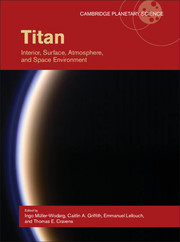Book contents
- Frontmatter
- Contents
- Contributors
- Introduction
- Prologue 1 The genesis of Cassini-Huygens
- Prologue 2 Building a space flight instrument: a PI's perspective
- 1 The origin and evolution of Titan
- 2 Titan's surface geology
- 3 Thermal structure of Titan's troposphere and middle atmosphere
- 4 The general circulation of Titan's lower and middle atmosphere
- 5 The composition of Titan's atmosphere
- 6 Storms, clouds, and weather
- 7 Chemistry of Titan's atmosphere
- 8 Titan's haze
- 9 Titan's upper atmosphere: thermal structure, dynamics, and energetics
- 10 Titan's upper atmosphere/exosphere, escape processes, and rates
- 11 Titan's ionosphere
- 12 Titan's magnetospheric and plasma environment
- Index
- References
4 - The general circulation of Titan's lower and middle atmosphere
Published online by Cambridge University Press: 05 January 2014
- Frontmatter
- Contents
- Contributors
- Introduction
- Prologue 1 The genesis of Cassini-Huygens
- Prologue 2 Building a space flight instrument: a PI's perspective
- 1 The origin and evolution of Titan
- 2 Titan's surface geology
- 3 Thermal structure of Titan's troposphere and middle atmosphere
- 4 The general circulation of Titan's lower and middle atmosphere
- 5 The composition of Titan's atmosphere
- 6 Storms, clouds, and weather
- 7 Chemistry of Titan's atmosphere
- 8 Titan's haze
- 9 Titan's upper atmosphere: thermal structure, dynamics, and energetics
- 10 Titan's upper atmosphere/exosphere, escape processes, and rates
- 11 Titan's ionosphere
- 12 Titan's magnetospheric and plasma environment
- Index
- References
Summary
4.1 Introduction
The atmosphere of Titan shares a specific circulation feature with the atmosphere of Venus, the so-called superrotation. Most of the middle and lower atmosphere rotates significantly faster than the underlying solid body, with maximum zonal winds in the winter stratosphere of ~200 m/s. This chapter focuses on this dominant feature, through discussions of all aspects of Titan's atmospheric dynamics. In such a complex system, interactions are strong among atmospheric circulation, temperature structure, composition of the atmosphere, and clouds and haze distributions. Therefore, close links are made with other chapters of this book: Chapter 3 for temperature structure, Chapter 5 for composition, and Chapters 6 and 8 for clouds and haze distributions.
The altitude region covered by this chapter goes from the surface to the detached haze layer, a peculiar feature located at the top of the haze completely covering Titan (see Chapter 8), at an altitude of roughly 500 km. This region includes the troposphere, the stratosphere, and the lower mesosphere (see Chapter 3). The troposphere goes from the surface up to ~40 km (the tropopause), where the coldest temperatures are found on Titan. In this region, the atmospheric system includes the cycle of methane, presenting features similar to the hydrological system in the Earth atmosphere (see Chapters 5 and 6). The stratosphere goes from the tropopause to the stratopause, where temperatures peak, located at altitudes around 250 to 300 km (around 0.1 mbar).
- Type
- Chapter
- Information
- TitanInterior, Surface, Atmosphere, and Space Environment, pp. 122 - 157Publisher: Cambridge University PressPrint publication year: 2014
References
- 10
- Cited by

